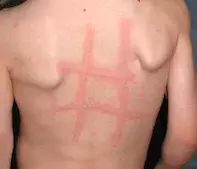What’s the diagnosis?
A young boy with persistent itch and no apparent rash

Case presentation
A 5-year-old boy presents with a history of constant scratching and complaints of itch. His mother says he gets red blotches on his skin that ‘come and go’ and that she has noticed that his nocturnal scratching has been severe enough to cause bleeding, as indicated by blood on his bed sheet in the morning. She has changed her washing powder and the child has been placed on a dairy-free and gluten-free diet, but his symptoms have not improved. The itching is distracting him at school.
The boy’s mother says that the problem started after the child and the rest of the family were first treated for scabies. Three further treatments for the whole family, as well as contact tracing and treatment and management of fomites, have not made any difference to his symptoms. No one else in the family is itchy.
On examination, some excoriations and broken skin are noted on the boy’s flanks, arm and lower limbs. There is no rash to be seen initially. However, lightly stroking the skin with the back surface of the examiner’s fingernail causes whealing (Figure). The skin is otherwise normal.
Diagnosis
The correct diagnosis is symptomatic dermographism, a subtype of inducible urticaria whereby a mechanical stimulus induces reproducible wheal-and-flare reactions with itching and burning sensation as a result of histamine release from cutaneous mast cells. It can occur at any age but the incidence is highest in children and young adults. Patients typically complain of whealing and itching at sites of trauma or friction with clothing or after scratching the skin. The itching is usually more intense than the skin changes suggest and is most severe at night. It often follows viral infections and allergic reactions and it is not uncommon after an episode of scabies.
Symptomatic dermographism should always be suspected when a patient complains of itch in the absence of abnormal skin, and the diagnosis is easily confirmed by scratching the skin. For the case patient described above, symptomatic dermographism was diagnosed after stroking the skin with a smooth blunt object (the back of the fingernail); whealing occurred after one to two minutes and lasted for 20 minutes. The same wheal response is commonly elicited in chronic urticaria.
Differential diagnoses
Conditions to consider among the differential diagnoses for a child of this age who presents with persistent itch include the following.
- Other inducible urticarias. Urticaria can be induced by nonmechanical stimuli. These include cholinergic urticaria (caused by overheating, exercise, stress, spicy foods) and contact urticaria, which may be allergic (e.g. food, animals, latex) or nonallergic (e.g. jellyfish). Other urticarial stimuli include vibration (e.g. jogging, use of a lawn mower) and thermal changes (more commonly cold but also heat and/or overheating).
- Scabies. This common parasitic infection should be considered in any patient presenting with intense pruritus. A widespread excoriated hypersensitivity rash usually follows infestation, and the diagnosis can be confirmed by findings of mites or burrows, typically in the finger webs, on dermoscopy. However, it is unlikely to be the correct diagnosis for this child, who does not have any rash, particularly after repeated treatment for scabies.
- Atopic dermatitis. This condition is characteristically very itchy and occurs with an observable rash accompanied by dry skin. Excoriations are present in the case patient described above, but these are secondary to scratching.
- Generalised xerosis. Children with dry skin usually have either atopic eczema (which is itchy) or ichthyosis (which is not itchy). In elderly patients, dryness can be symptomatic, particularly in winter when ambient humidity is low, but this is unusual in children.
- Drug reactions. Itching that commences after a patient starts a new medication should always be considered to be associated with the medication. A trial of medication cessation should follow.
- Systemic diseases. Cholestatic hepatic disease, renal failure, thyrotoxicosis and iron deficiency have all been associated with itch without a rash. In an otherwise healthy child, these conditions are very unlikely.
- Haematological malignancy. Hodgkin's lymphoma, polycythaemia rubra vera and other haematological malignancies may present with itch. These diagnoses are unlikely in a child of this age who is generally well.
Management
The prognosis for patients with symptomatic dermographism is good, with eventual spontaneous resolution occurring in most cases. Patient education about the condition and demonstration of the mechanical wheal response is useful and reinforces the value of nonspecific management measures. These include wearing loose-fitting clothes (especially at night) and minimising exposure to aggravating factors, such as extreme heat or cold.
Patients frequently suspect allergy to foods, and a food diary may be helpful. There are no detailed data on associated diseases in symptomatic dermographism, but it has been described in patients after an episode of scabies, a drug reaction, hypothyroidism or hyperthyroidism, infectious diseases, diabetes mellitus and onset of menopause.1 Thyroid function and antibody testing may be of benefit if a patient has symptoms suggestive of thyroid disease.
Oral antihistamines (H1 antihistamines) are first line treatment in all urticarias. However, patients should be warned of possible sedative side effects, with sedating antihistamines reserved for evening use to improve sleep quality. Nonsedating antihistamines should be given in the morning. They do not always eradicate the rash but diminish the itch by blocking histamine receptors. If response to an H1 antihistamine is inadequate then the dose may be doubled. An H2 antihistamine may also be given in combination.2
References
1. Taşkapan O, Harmanyeri Y. Evaluation of patients with symptomatic dermographism. J Eur Acad Dermatol Venereol 2006; 20: 58-62.
2. Breathnach SM, Allen R, Ward AM, Greaves MW. Symptomatic dermographism: natural history, clinical features, laboratory investigations and response to therapy. Clin Exp Dermatol 1983; 8: 463-476.

